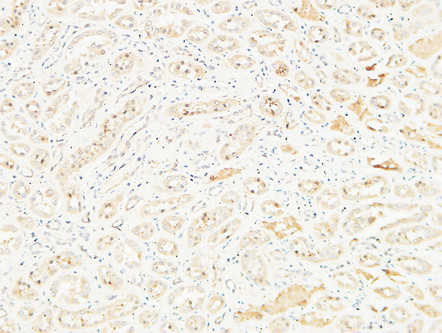CD26 Polyclonal Antibody
- Catalog No.:YT5707
- Applications:WB;IHC;IF;ELISA
- Reactivity:Human;Rat;Mouse;
- Target:
- CD26
- Fields:
- >>Protein digestion and absorption
- Gene Name:
- DPP4
- Protein Name:
- Dipeptidyl peptidase 4
- Human Gene Id:
- 1803
- Human Swiss Prot No:
- P27487
- Mouse Swiss Prot No:
- P28843
- Immunogen:
- The antiserum was produced against synthesized peptide derived from the Internal region of human DPP4. AA range:350-400
- Specificity:
- CD26 Polyclonal Antibody detects endogenous levels of CD26 protein.
- Formulation:
- Liquid in PBS containing 50% glycerol, 0.5% BSA and 0.02% sodium azide.
- Source:
- Polyclonal, Rabbit,IgG
- Dilution:
- WB 1:500 - 1:2000. IHC: 1:100-1:300. ELISA: 1:10000.. IF 1:50-200
- Purification:
- The antibody was affinity-purified from rabbit antiserum by affinity-chromatography using epitope-specific immunogen.
- Concentration:
- 1 mg/ml
- Storage Stability:
- -15°C to -25°C/1 year(Do not lower than -25°C)
- Other Name:
- DPP4;ADCP2;CD26;Dipeptidyl peptidase 4;ADABP;Adenosine deaminase complexing protein 2;ADCP-2;Dipeptidyl peptidase IV;DPP IV;T-cell activation antigen CD26;TP103;CD26
- Observed Band(KD):
- 105kD
- Background:
- The protein encoded by this gene is identical to adenosine deaminase complexing protein-2, and to the T-cell activation antigen CD26. It is an intrinsic membrane glycoprotein and a serine exopeptidase that cleaves X-proline dipeptides from the N-terminus of polypeptides. [provided by RefSeq, Jul 2008],
- Function:
- catalytic activity:Release of an N-terminal dipeptide, Xaa-Yaa-|-Zaa-, from a polypeptide, preferentially when Yaa is Pro, provided Zaa is neither Pro nor hydroxyproline.,function:Removes N-terminal dipeptides sequentially from polypeptides having unsubstituted N-termini provided that the penultimate residue is proline. Plays a role in T-cell activation.,online information:Dipeptidyl peptidase-4 entry,PTM:The soluble form (SDPP) derives from the membrane form (MDPP) by proteolytic processing.,similarity:Belongs to the peptidase S9B family. DPPIV subfamily.,subunit:Homodimer or heterodimer with Seprase (FAP).,tissue specificity:Expressed in the poorly differentiated crypt cells of the small intestine as well as in the mature villous cells. Expressed at very low levels in the colon.,
- Subcellular Location:
- [Dipeptidyl peptidase 4 soluble form]: Secreted . Detected in the serum and the seminal fluid. .; Cell membrane ; Single-pass type II membrane protein. Apical cell membrane ; Single-pass type II membrane protein. Cell projection, invadopodium membrane ; Single-pass type II membrane protein. Cell projection, lamellipodium membrane ; Single-pass type II membrane protein. Cell junction . Membrane raft . Translocated to the apical membrane through the concerted action of N- and O-Glycans and its association with lipid microdomains containing cholesterol and sphingolipids (PubMed:11773049). Redistributed to membrane rafts in T-cell in an interleukin-12-dependent activation (PubMed:12676959). Its interaction with CAV1 is necessary for its translocation to membrane rafts (PubMed:17287217). Coloca
- Expression:
- Expressed specifically in lymphatic vessels but not in blood vessels in the skin, small intestine, esophagus, ovary, breast and prostate glands. Not detected in lymphatic vessels in the lung, kidney, uterus, liver and stomach (at protein level). Expressed in the poorly differentiated crypt cells of the small intestine as well as in the mature villous cells. Expressed at very low levels in the colon.
HMGCL-induced β-hydroxybutyrate production attenuates hepatocellular carcinoma via DPP4-mediated ferroptosis susceptibility Hepatology International Cui, Xiaohan, Yun, Xiao, Sun, Meiling, Li, Renzhi, Lyu, Xiajie, Lao, Yuanxiang, Yu, Wenbin, Qin, Xihu WB Human Huh7 cell, MHCC-LM3 cell
- June 19-2018
- WESTERN IMMUNOBLOTTING PROTOCOL
- June 19-2018
- IMMUNOHISTOCHEMISTRY-PARAFFIN PROTOCOL
- June 19-2018
- IMMUNOFLUORESCENCE PROTOCOL
- September 08-2020
- FLOW-CYTOMEYRT-PROTOCOL
- May 20-2022
- Cell-Based ELISA│解您多样本WB检测之困扰
- July 13-2018
- CELL-BASED-ELISA-PROTOCOL-FOR-ACETYL-PROTEIN
- July 13-2018
- CELL-BASED-ELISA-PROTOCOL-FOR-PHOSPHO-PROTEIN
- July 13-2018
- Antibody-FAQs
- Products Images

- Western blot analysis of 293T 3T3 lysis using DPP4 antibody. Antibody was diluted at 1:500. Secondary antibody(catalog#:RS0002) was diluted at 1:20000

- Immunohistochemical analysis of paraffin-embedded human-kidney, antibody was diluted at 1:200

- Immunohistochemical analysis of paraffin-embedded Human kidney. 1, Antibody was diluted at 1:100(4° overnight). 2, High-pressure and temperature EDTA, pH8.0 was used for antigen retrieval. 3,Secondary antibody was diluted at 1:200(room temperature, 30min).



